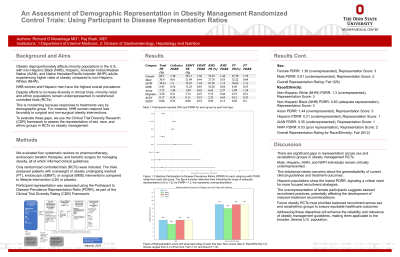Sunday Poster Session
Category: Obesity
P1444 - An Assessment of Demographic Representation in Obesity Management Randomized Control Trials: Using Participant to Disease Prevalence Representation Ratios
Sunday, October 27, 2024
3:30 PM - 7:00 PM ET
Location: Exhibit Hall E

Has Audio
.jpg)
Richard Maradiaga, MD
The Ohio State University Wexner Medical Center
Columbus, OH
Presenting Author(s)
Richard Maradiaga, MD, Raj Shah, MD
The Ohio State University Wexner Medical Center, Columbus, OH
Introduction: Obesity is a global issue, notably impacting minority communities in the United States. An evaluation of surgical and non-surgical RCTs that inform guidelines for the treatment of obesity regarding diversity in patient population demographics has not been done. Hence, we aimed to assess the representation of patient demographics to enhance our understanding the applicability of clinical recommendations and the current body of evidence.
Methods: We identified recently published guidelines and systematic reviews and reviewed the bibliographies for randomized clinical trials (RCTs) evaluating patients with obesity undergoing an intervention (medical therapy, endoscopic therapy, or bariatric surgery) versus lifestyle intervention (LSI) or intervention for non-inferiority. Extraction of age, sex, gender, race, and ethnicity was completed. We used a tool recommended to be used to assess diversity in clinical trials, Participant to Disease Prevalence Representation Ratio (PDRR), and linear regression for analysis.
Results: A total of 55,660 participants were assessed, of which 69.1% were female. There was a slight non-significant increase in male participation over time (p = 0.467). 40.8% (69/167) of studies reported race and ethnicity, corresponding to 41,047 participants, with 76.4% being non-Hispanic White (NHW), 8.95% non-Hispanic Black (NHB), 3.7% Asian, 4.28% Hispanic/Latino, and 5.8 % were identified as “other.” The PDRR for females was 1.38 and 0.61 for males, with a representation score of 5 and a grade of Fair for sex representation. The PDRRs were 1.3, 0.56, 1.44, and 0.21 for those identified as NHW, NHB, Asian, and Hispanic, respectively. A representation score of 9 and a grade of Fair were assigned to race and ethnicity. PDRR was not calculated for older individuals due to a lack of data. (Table 1)
Discussion: Most participants were noted to be female, with a small increase in male participation over time. The PDRR of females, NHW, and Asian participants were >1.2, signifying overrepresentation in obesity research. A rating of Fair was given to race/ethnicity; however, there are deficits in NHB and Hispanic representation, populations for which obesity and severe obesity rates have drastically increased over the last two decades. Racial disparities persist, indicating a need for more representative research to enhance the applicability of clinical guidelines.
Note: The table for this abstract can be viewed in the ePoster Gallery section of the ACG 2024 ePoster Site or in The American Journal of Gastroenterology's abstract supplement issue, both of which will be available starting October 27, 2024.
Disclosures:
Richard Maradiaga, MD, Raj Shah, MD. P1444 - An Assessment of Demographic Representation in Obesity Management Randomized Control Trials: Using Participant to Disease Prevalence Representation Ratios, ACG 2024 Annual Scientific Meeting Abstracts. Philadelphia, PA: American College of Gastroenterology.
The Ohio State University Wexner Medical Center, Columbus, OH
Introduction: Obesity is a global issue, notably impacting minority communities in the United States. An evaluation of surgical and non-surgical RCTs that inform guidelines for the treatment of obesity regarding diversity in patient population demographics has not been done. Hence, we aimed to assess the representation of patient demographics to enhance our understanding the applicability of clinical recommendations and the current body of evidence.
Methods: We identified recently published guidelines and systematic reviews and reviewed the bibliographies for randomized clinical trials (RCTs) evaluating patients with obesity undergoing an intervention (medical therapy, endoscopic therapy, or bariatric surgery) versus lifestyle intervention (LSI) or intervention for non-inferiority. Extraction of age, sex, gender, race, and ethnicity was completed. We used a tool recommended to be used to assess diversity in clinical trials, Participant to Disease Prevalence Representation Ratio (PDRR), and linear regression for analysis.
Results: A total of 55,660 participants were assessed, of which 69.1% were female. There was a slight non-significant increase in male participation over time (p = 0.467). 40.8% (69/167) of studies reported race and ethnicity, corresponding to 41,047 participants, with 76.4% being non-Hispanic White (NHW), 8.95% non-Hispanic Black (NHB), 3.7% Asian, 4.28% Hispanic/Latino, and 5.8 % were identified as “other.” The PDRR for females was 1.38 and 0.61 for males, with a representation score of 5 and a grade of Fair for sex representation. The PDRRs were 1.3, 0.56, 1.44, and 0.21 for those identified as NHW, NHB, Asian, and Hispanic, respectively. A representation score of 9 and a grade of Fair were assigned to race and ethnicity. PDRR was not calculated for older individuals due to a lack of data. (Table 1)
Discussion: Most participants were noted to be female, with a small increase in male participation over time. The PDRR of females, NHW, and Asian participants were >1.2, signifying overrepresentation in obesity research. A rating of Fair was given to race/ethnicity; however, there are deficits in NHB and Hispanic representation, populations for which obesity and severe obesity rates have drastically increased over the last two decades. Racial disparities persist, indicating a need for more representative research to enhance the applicability of clinical guidelines.
Note: The table for this abstract can be viewed in the ePoster Gallery section of the ACG 2024 ePoster Site or in The American Journal of Gastroenterology's abstract supplement issue, both of which will be available starting October 27, 2024.
Disclosures:
Richard Maradiaga indicated no relevant financial relationships.
Raj Shah indicated no relevant financial relationships.
Richard Maradiaga, MD, Raj Shah, MD. P1444 - An Assessment of Demographic Representation in Obesity Management Randomized Control Trials: Using Participant to Disease Prevalence Representation Ratios, ACG 2024 Annual Scientific Meeting Abstracts. Philadelphia, PA: American College of Gastroenterology.
